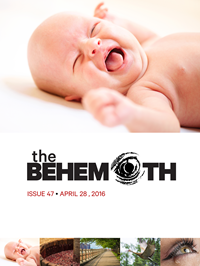Wonder on the Web
Issue 47: Links to amazing stuff.
This issue’s Wonder on the Web items came to us through members of Entheos, our new, official, very enthusiastic, “secret” Facebook group. Want to join the conversation? Email us at help@behemothmag.com with “Facebook Group” as the subject line and your Facebook email in the message. We want to see you there and hear what bits of awe and wonder you’re finding around the web.
The topography of tears
Photographer Rose-Lynn Fisher wanted to view grief under a microscope. She captured hundreds of human tears (from herself and other volunteers) on slides, then viewed the dried tears under a scanning electron microscope. The result is what she calls “aerial views of emotion terrain”: tears of grief, but also tears of timeless reunion, joy, and laughter. And onion tears, for good measure. (Thanks to Behemoth reader Diane Fillmore for tipping us to this surprising Smithsonian magazine profile!)
Hearing the lost sounds of antiquity
The Atlantic describes how researchers are mapping the acoustics of ancient churches. The project started when UCLA professor Sharon Gerstel realized how much is left out when we view Byzantine art without its intended accompaniments, like music and chants. “So many paintings of a certain period contain representations of hymns and hymnographers,” she says, “but people were looking at these paintings as if they were mute.” The data collected by Gerstel’s team is being used to recreate and preserve the original sound of ancient worship, deepening our understanding of how church architecture was designed to bring the multi-sensory experience of art, music, and worship together. They’ve even discovered the sound of “angels’ wings.” (We’re unsurprised that this recommendation came from our marketing manager, Leanne Snavely, whose work is also accompanied by music all day.)
More feathers
We’re still smitten by our last issue’s Robert Clark photo essay on simply beautiful feathers. Fortunately, so is Behemoth writer Joel Bezaire, who shared microscopic photos of a peacock’s iridescent plumage taken by software engineer Waldo Nell. We were so wowed we got lost following links until we landed on a 2003 journal article describing the photonic-crystal structure that makes peacock feathers so colorful. It’s pretty dense and we won’t pretend to understand all of it. But we love that it’s so complicated just to describe what colors these feathers are and how those colors are made.
Cellmates
“This is a story about two people sharing one body. Maybe even three people. Or four.” (What a lede, NPR!) How is this possible? During pregnancy, cells from the baby can cross the placenta and end up in the mother’s bloodstream. From there, they can go into the organs, becoming liver cells, muscle cells, even neurons. But the process works in the other direction, too—so since “your mom had cells in her body from all her other pregnancies and her mom … you likely have cells from your older siblings, and from your grandmother, and maybe even your great-grandmother.” New research suggests these cells may reduce the risk of certain diseases, like breast cancer. (See also Alec Hill’s article, “My New Life as a Chimera,” from issue 43.) “I find the idea of microchimeric cells fascinating,” Today’s Christian Woman editor Kelli B. Trujillo told us when she sent along this article. “I’ve borne 3 children, and it’s stunning to think that their unique cells are now part of the functioning of my own body.”
Also in this Issue
Issue 47 / April 28, 2016- Editor's Note from April 28, 2016
Issue 47: A good, dreadful covenant mark; wine’s life from grapes’ decay; and nature’s remedy. /
- Why Did God Choose Circumcision?
The hopeful, beautiful, and terrible reason for the drastic covenant. /
- Wine, Wine, Wine!
We’ve turned dying fruit into a durable drink for millennia but only recently understood it. /
- How Nature Soothes the Soul
Scientific evidence for the benefits of outdoor recreation. /
- The Cranes
“Where along the migratory way” /


